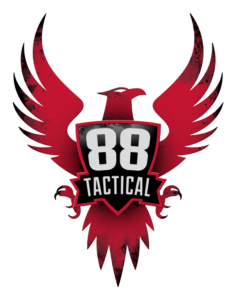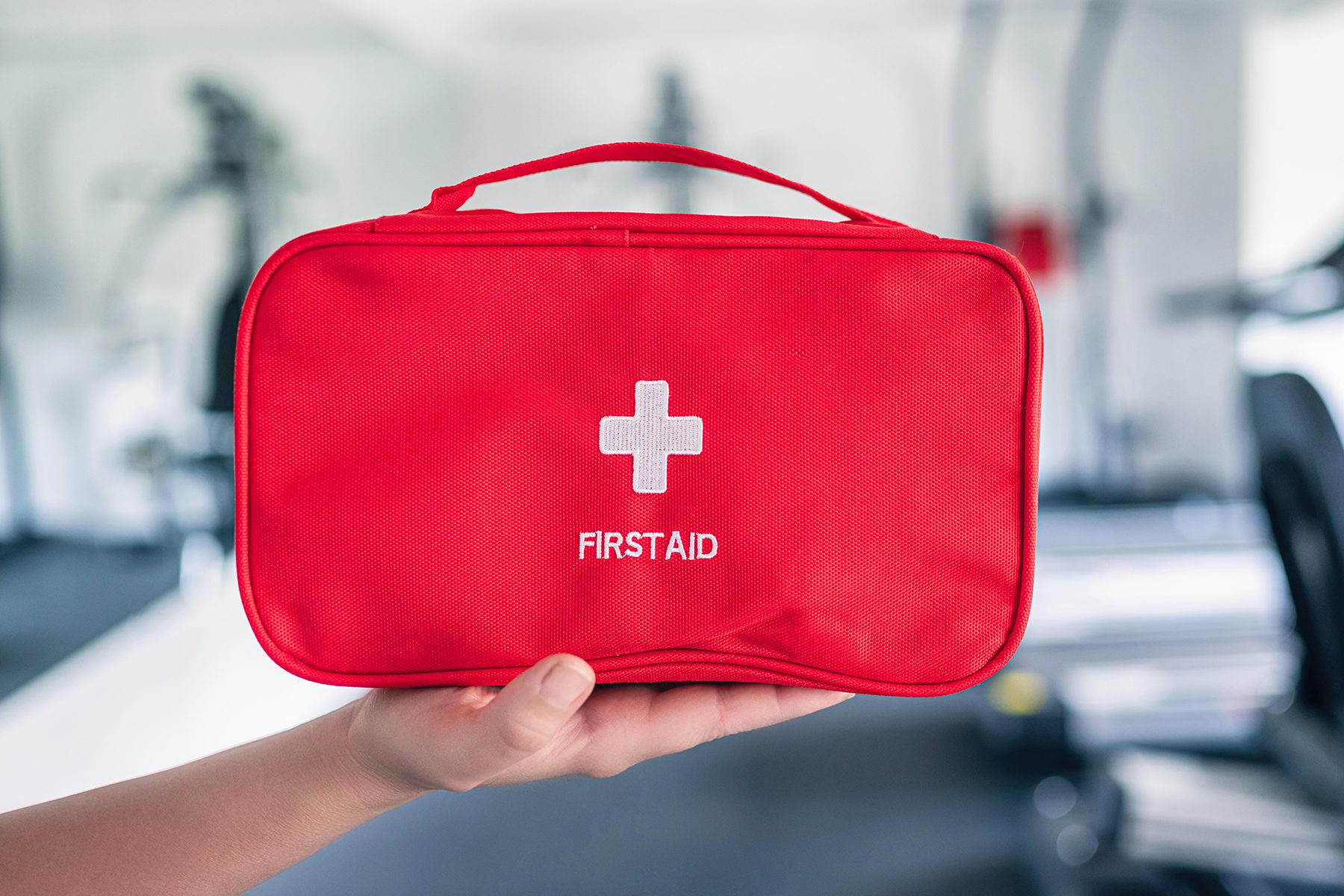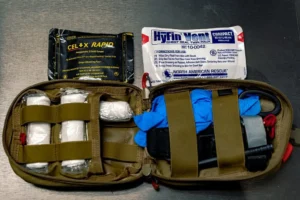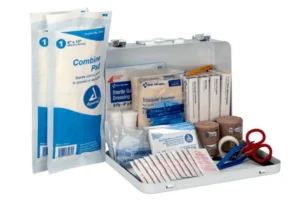People often confuse a trauma kit vs first aid kit. They are both necessary, but very different. It’s important to have the right tools for the job. Using a Band-Aid for an arterial bleed or a tourniquet to treat a minor cut wouldn’t make sense.
Trauma Kit Vs First Aid Kit: What’s the Difference?
What is a Trauma Kit?
A trauma kit is a medical kit that contains supplies to deal with life-threatening injuries and bleeding control.
What is a First Aid Kit?
A first aid kit is a collection of supplies for treating minor injuries, including cuts, scrapes, burns, and sprains.
What should be included in a trauma kit?
1. Trauma Shears
These should always be included in an emergency medical kit because sometimes it’s necessary to cut away clothing to get to a wound so it can be properly assessed and treated.
2. Sterile Disposable Gloves
Sterile disposable gloves are an absolute necessity to help protect the caregiver from blood-borne pathogens. Try to avoid black gloves, they make it more difficult to perform a rapid causality assessment because blood will be less visible on the hands, especially in low-light situations.
3. Tourniquet
A trauma kit should always contain a tourniquet to stop major bleeding from a limb. There are many types of tourniquets on the market to help stop the bleeding, but make sure the option you choose is approved by the Committee on Tactical Combat Casualty Care (CoTCCC).
We advise steering clear of tourniquet knockoffs on websites like Amazon. They may seem like a great deal, but you do not want your life or the life of someone you care about to depend on a cheap knockoff. To avoid knockoffs, all your medical gear should be bought from a reputable website or company. Knockoffs aren’t completely useless – they can be great training tools. You should always have a separate training tourniquet because even the good brands will wear out eventually with repeated use.
4. Hemostatic Agents
These aren’t an absolute necessity, but they are extremely helpful. They are typically used when:
- Normal bleeding control methods are ineffective.
- There is a delayed response from EMS.
- The patient is in a distant area far from professional medical care.
Hemostatic agents come in two forms: granular powder and embedded/impregnated dressings.
When looking at hemostatic agents, the two that are commonly used are Quikclot and Celox.
- Quikclot consists of a non-woven material impregnated with Kaolin which accelerates the body’s natural clotting ability. Since it makes use of the body’s natural clotting ability, it’s not the best choice for people who are taking blood thinners.
- Celox is made up of chitosan, which is a natural polymer extracted from shrimp shells. Celox works independently of the body’s normal clotting mechanism, so it is the ideal choice for people who are taking blood thinners. People with shellfish allergies don’t need to worry about having a bad reaction to Celox because there have been no known or suspected allergic reactions and it has been extensively tested.
5. Pressure Dressings
These are a necessary item for any trauma kit. They can be used in conjunction with other bleeding control methods or in areas that contradict the use of tourniquets. Just like with tourniquets, there are many options when it comes to pressure dressings. Be sure to pick an option you can use efficiently.
6. Chest Seals
Chest seals are used to treat open and/or sucking chest wounds. They come vented and non-vented. Chest seals are used to treat chest wall defects between the collar bones and the belly button. Not all penetrating torso trauma will have air actively moving in and out of the injury, but all of these injuries need to be sealed regardless.
These essential items are a great setup for a very basic trauma kit. There are much more advanced kits available, but unless you are a medical professional, it’s a good idea to stick with the basics. While having the right tools is important, they are virtually useless without the knowledge and training to use them properly.
TacMed Training
Training is a key component of successfully responding to an emergency situation. Training classes are an excellent way to build foundational knowledge. 88 Tactical sells complete trauma (TacMed) kits in the pro shop but also offers Basic to Advanced TacMed courses. Basic TacMed teaches basic life-saving skills and gives a thorough overview of how to use the equipment in a trauma kit. After going through a basic training course, it’s important to practice on your own and take follow-up training courses to keep your skills fresh.
What should be included in the first aid kit?
While First Aid kits are meant for minor injuries, taking a First Aid class will provide you with a better understanding of how to properly use the supplies in the kit. Always keep a first aid manual with your supplies.
1. Disposable Sterile Gloves
Like trauma kits, first aid kits should contain disposable sterile gloves to protect the caregiver and shears, in case clothing needs to be cut away to assess and treat an injury properly.
2. Tweezers
These are another helpful item to remove debris from a wound, such as splinters, small rocks, or glass shards.
3. Bandages
Band-Aids and sterile gauze in a variety of sizes should be included for minor cuts, scrapes, and burns. Crêpe rolled bandages are another must-have to secure dressing or to support soft tissue injuries like sprains. On that note, triangular bandages are another helpful item for bandaging wounds, immobilizing fractures and dislocations, or using a sling to support an injured part of the body. Don’t forget safety pins!
4. Creams, Painkillers, and Antihistamines
When dealing with minor injuries, antiseptic creams can help reduce the likelihood of infection. Antihistamine creams or tablets can be valuable when dealing with mild allergies. Over-the-counter painkillers like Tylenol or ibuprofen will reduce pain, swelling, and fever.
T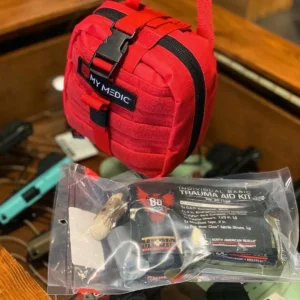 rauma Kits & First Aid Kits Available at 88 Tactical
rauma Kits & First Aid Kits Available at 88 Tactical
Many other optional items like ice packs and extensive wound cleaning/eye flushing solutions can be included in a more comprehensive first aid kit, but the above items are a great start for a basic kit. 88 Tactical sells both first aid kits and trauma kits.
One kit is not a replacement for the other. We recommend keeping both types of kits on hand (at home and in your vehicle) so you’re prepared, no matter the situation.
Questions About Trauma Kit vs First Aid Kit?
If you have any questions about 88 Tactical TacMed classes or the First Aid Kits and Trauma Kits sold in the pro shop, please contact us!
